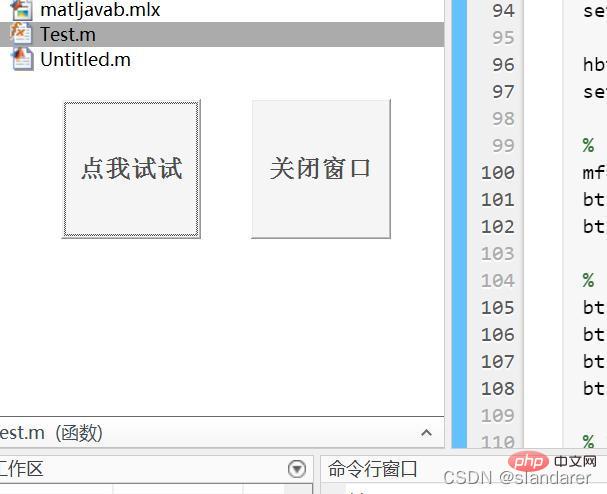1 Get the mouse position in the full screen
The upper left corner of the screen is the origin of the coordinates. It is recommended to use it in conjunction with a while loop or timer function to get the mouse position and mouse pixel color:
import java.awt.MouseInfo; mousepoint=MouseInfo.getPointerInfo().getLocation(); mousepoint=[mousepoint.x,mousepoint.y]
2 Get the current Clipboard content
import java.awt.Toolkit import java.awt.datatransfer.DataFlavor clip=Toolkit.getDefaultToolkit().getSystemClipboard(); clipTf=clip.getContents([]); clipContent=clipTf.getTransferData(DataFlavor.stringFlavor)
3 Copy the content to the clipboard
import java.awt.Toolkit; import java.awt.datatransfer.StringSelection; clip=Toolkit.getDefaultToolkit().getSystemClipboard(); contentStr='歡迎關注slandarer隨筆'; tText=StringSelection(contentStr); clip.setContents(tText,[]);
4 Get the pixel color at the mouse position
Needs to be combined with the function to get the mouse position.
import java.awt.MouseInfo; import java.awt.Robot; robot=Robot(); mousepoint=MouseInfo.getPointerInfo().getLocation(); tempColor=robot.getPixelColor(mousepoint.x, mousepoint.y); RGBColor=[tempColor.getRed(),tempColor.getGreen(),tempColor.getBlue()]
5 Get screenshot
import java.awt.Robot; import java.awt.Rectangle; robot=Robot(); rectangle=Rectangle(); screensize=get(0,'screensize'); screensize=1.5*screensize; rectangle.x=0; rectangle.y=0; rectangle.width=screensize(3); rectangle.height=screensize(4); image=robot.createScreenCapture(rectangle); data=image.getData(); temp=zeros(screensize(3)*screensize(4)*3,1); temp=data.getPixels(0,0,screensize(3),screensize(4),temp); temp=uint8(temp); R=temp(1:3:end); G=temp(2:3:end); B=temp(3:3:end); R=reshape(R,[screensize(3),screensize(4)]); G=reshape(G,[screensize(3),screensize(4)]); B=reshape(B,[screensize(3),screensize(4)]); R=R';G=G';B=B'; ima=cat(3,R,G,B); imshow(ima)
6 Create java window (and keep it always on top)
import java.awt.Frame; import java.awt.Point; frame=Frame(); % 設置java窗口大小 frame.setSize(400,300) % 設置java窗口位置 point=Point(300,200); frame.setLocation(point) % 使其永遠在最上方 frame.setAlwaysOnTop(true); % 設置窗口關閉回調(diào)(不設置的話java frame將無法關閉) hjWindow=handle(frame,'CallbackProperties'); set(hjWindow,'WindowClosingCallback',@(h,e)frame.dispose()); % 顯示java窗口 frame.setVisible(true)
7 Transparent window
import java.awt.Frame;
import java.awt.Point;
import java.awt.Button;
import java.awt.Font;
frame=Frame();
% 設置java窗口大小
frame.setSize(400,200)
% 設置java窗口位置
point=Point(50,400);
frame.setLocation(point)
% 因為要依據(jù)數(shù)值設置按鈕位置,因此setLayout(NULL)
frame.setLayout([]);
bt1=Button("點我試試");
bt2=Button("關閉窗口");
% 設置點擊事件
hbt1=handle(bt1,'CallbackProperties');
set(hbt1,'MousePressedCallback',@(h,e)disp('歡迎關注公眾號slandarer隨筆'))
hbt2=handle(bt2,'CallbackProperties');
set(hbt2,'MousePressedCallback',@(h,e)frame.dispose())
% 設置按鈕字體及字號
mf=Font('宋體',Font.BOLD,25);
bt1.setFont(mf)
bt2.setFont(mf)
% 設置按鈕位置
bt1.setLocation(30,30);
bt1.setSize(140,140);
bt2.setLocation(220,30);
bt2.setSize(140,140);
% 添加按鈕
frame.add(bt1);
frame.add(bt2);
% 取消邊框并設置透明度
frame.setUndecorated(true);
frame.setOpacity(.7);
% 設置窗口關閉回調(diào)
hjWindow=handle(frame, 'CallbackProperties');
set(hjWindow, 'WindowClosingCallback', @(h,e)frame.dispose());
% 顯示java窗口
frame.setVisible(true)
The above is the detailed content of What are the Java operations that come with Matlab?. For more information, please follow other related articles on the PHP Chinese website!

Hot AI Tools

Undress AI Tool
Undress images for free

Undresser.AI Undress
AI-powered app for creating realistic nude photos

AI Clothes Remover
Online AI tool for removing clothes from photos.

Clothoff.io
AI clothes remover

Video Face Swap
Swap faces in any video effortlessly with our completely free AI face swap tool!

Hot Article

Hot Tools

Notepad++7.3.1
Easy-to-use and free code editor

SublimeText3 Chinese version
Chinese version, very easy to use

Zend Studio 13.0.1
Powerful PHP integrated development environment

Dreamweaver CS6
Visual web development tools

SublimeText3 Mac version
God-level code editing software (SublimeText3)
 How to handle transactions in Java with JDBC?
Aug 02, 2025 pm 12:29 PM
How to handle transactions in Java with JDBC?
Aug 02, 2025 pm 12:29 PM
To correctly handle JDBC transactions, you must first turn off the automatic commit mode, then perform multiple operations, and finally commit or rollback according to the results; 1. Call conn.setAutoCommit(false) to start the transaction; 2. Execute multiple SQL operations, such as INSERT and UPDATE; 3. Call conn.commit() if all operations are successful, and call conn.rollback() if an exception occurs to ensure data consistency; at the same time, try-with-resources should be used to manage resources, properly handle exceptions and close connections to avoid connection leakage; in addition, it is recommended to use connection pools and set save points to achieve partial rollback, and keep transactions as short as possible to improve performance.
 Understanding the Java Virtual Machine (JVM) Internals
Aug 01, 2025 am 06:31 AM
Understanding the Java Virtual Machine (JVM) Internals
Aug 01, 2025 am 06:31 AM
TheJVMenablesJava’s"writeonce,runanywhere"capabilitybyexecutingbytecodethroughfourmaincomponents:1.TheClassLoaderSubsystemloads,links,andinitializes.classfilesusingbootstrap,extension,andapplicationclassloaders,ensuringsecureandlazyclassloa
 How to work with Calendar in Java?
Aug 02, 2025 am 02:38 AM
How to work with Calendar in Java?
Aug 02, 2025 am 02:38 AM
Use classes in the java.time package to replace the old Date and Calendar classes; 2. Get the current date and time through LocalDate, LocalDateTime and LocalTime; 3. Create a specific date and time using the of() method; 4. Use the plus/minus method to immutably increase and decrease the time; 5. Use ZonedDateTime and ZoneId to process the time zone; 6. Format and parse date strings through DateTimeFormatter; 7. Use Instant to be compatible with the old date types when necessary; date processing in modern Java should give priority to using java.timeAPI, which provides clear, immutable and linear
 Comparing Java Frameworks: Spring Boot vs Quarkus vs Micronaut
Aug 04, 2025 pm 12:48 PM
Comparing Java Frameworks: Spring Boot vs Quarkus vs Micronaut
Aug 04, 2025 pm 12:48 PM
Pre-formanceTartuptimeMoryusage, Quarkusandmicronautleadduetocompile-Timeprocessingandgraalvsupport, Withquarkusoftenperforminglightbetterine ServerLess scenarios.2.Thyvelopecosyste,
 How does garbage collection work in Java?
Aug 02, 2025 pm 01:55 PM
How does garbage collection work in Java?
Aug 02, 2025 pm 01:55 PM
Java's garbage collection (GC) is a mechanism that automatically manages memory, which reduces the risk of memory leakage by reclaiming unreachable objects. 1.GC judges the accessibility of the object from the root object (such as stack variables, active threads, static fields, etc.), and unreachable objects are marked as garbage. 2. Based on the mark-clearing algorithm, mark all reachable objects and clear unmarked objects. 3. Adopt a generational collection strategy: the new generation (Eden, S0, S1) frequently executes MinorGC; the elderly performs less but takes longer to perform MajorGC; Metaspace stores class metadata. 4. JVM provides a variety of GC devices: SerialGC is suitable for small applications; ParallelGC improves throughput; CMS reduces
 Understanding Network Ports and Firewalls
Aug 01, 2025 am 06:40 AM
Understanding Network Ports and Firewalls
Aug 01, 2025 am 06:40 AM
Networkportsandfirewallsworktogethertoenablecommunicationwhileensuringsecurity.1.Networkportsarevirtualendpointsnumbered0–65535,withwell-knownportslike80(HTTP),443(HTTPS),22(SSH),and25(SMTP)identifyingspecificservices.2.PortsoperateoverTCP(reliable,c
 go by example defer statement explained
Aug 02, 2025 am 06:26 AM
go by example defer statement explained
Aug 02, 2025 am 06:26 AM
defer is used to perform specified operations before the function returns, such as cleaning resources; parameters are evaluated immediately when defer, and the functions are executed in the order of last-in-first-out (LIFO); 1. Multiple defers are executed in reverse order of declarations; 2. Commonly used for secure cleaning such as file closing; 3. The named return value can be modified; 4. It will be executed even if panic occurs, suitable for recovery; 5. Avoid abuse of defer in loops to prevent resource leakage; correct use can improve code security and readability.
 Comparing Java Build Tools: Maven vs. Gradle
Aug 03, 2025 pm 01:36 PM
Comparing Java Build Tools: Maven vs. Gradle
Aug 03, 2025 pm 01:36 PM
Gradleisthebetterchoiceformostnewprojectsduetoitssuperiorflexibility,performance,andmoderntoolingsupport.1.Gradle’sGroovy/KotlinDSLismoreconciseandexpressivethanMaven’sverboseXML.2.GradleoutperformsMaveninbuildspeedwithincrementalcompilation,buildcac






